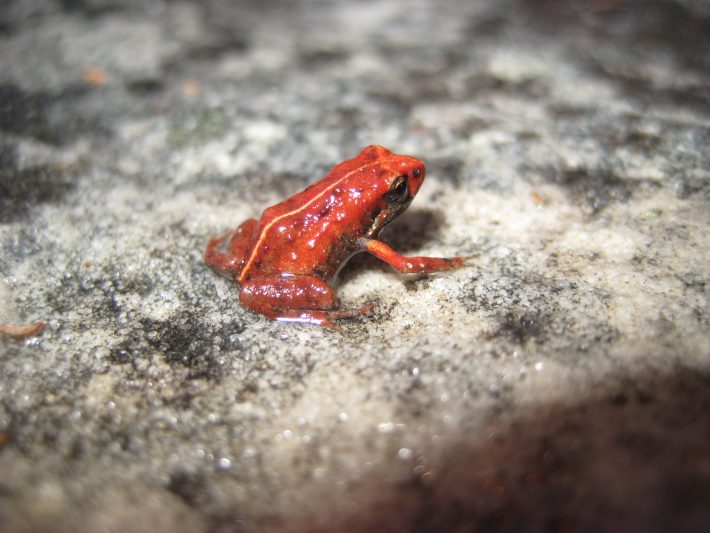Q&A: Cryptic frogs, counting chirps and conservation
“They are very small (~2 cm) and extremely hard to find. Their calls remind me of sleigh bells. When walking on the mountains around here, calls of this species are always an indication that there’s wet habitat ahead.”

The Cape peninsula moss frog is a common frog, but one that very few people have seen. It is the subject of a new research article looking at an acoustic technique to monitor the species without disturbance. In this Q&A, the BES Press Officer Becky Allen, interviews John Measey (@AfriHerp), the author of the article ‘Counting chirps: acoustic monitoring of cryptic frogs’.
Can you give me a little detail about the distribution and habitat of the Cape peninsula moss frog?
The distribution of this frog is confined to the Cape peninsula, immediately south of Cape Town. It’s a very limited area, and the frogs are mostly found in the montane areas. Fynbos (literally meaning “fine bush”) is an incredibly diverse Mediterranean shrubland – full of flowers at this time of the year. It’s also a fire-driven habitat, fires pass through at around 15-year intervals. One of the main threats to their habitat is the invasion of Australian acacias and pines, which themselves are tolerant of fire, and resprout or grow from a large seed bank. As these types of trees are woody, they tend to increase the intensity of fires and when growing they dry out the wetland habitats, none of which is good for these frogs. When walking on the mountains around here, calls of this species are always an indication that there’s wet habitat ahead.
You talk about amphibian declines generally. What do we know about the numbers of this species?
We have an ongoing project (using the same technique as this study) to look at the overall distribution of this species. It’s quite abundant where it occurs, but is constantly losing habitat as Cape Town expands (plus there are issues with fire frequency and intensity and invasive species). So, we hope to be able to tell you about their numbers by the end of the year.
Why are amphibians declining faster than any other vertebrates?
Habitat decline is still the number one reason, but there are multiple other factors including disease and invasive species, which have had a disproportionate effect, when compared with other vertebrates.
Conserving species obviously depends on having accurate monitoring data. Why are some species so hard to monitor, and what are the advantages of using acoustic monitoring techniques?
If you can’t see your study organism, that makes it immediately more difficult as we have relied on visual processes to monitor in the past. Acoustic monitoring is passive (rather like a camera trap) and so allows us to study species without disturbing them.
What did you set out to do and test in this study?
First, we wanted to know whether the monitoring approach – acoustic spatially explicit capture–recapture (aSCR) was practical in the field. The methodology was already known, but carrying out surveys and using it in a monitoring framework can be challenging for unforeseen reasons. In addition, we were interested to know when it is best to monitor these particular frogs. We would want to monitor them when most of the population (of males) is calling, and we hypothesised that this would be at the warmest time, or after rain.
Tell me a bit about the technology techniques you tested and what you discovered?
We recorded around 40 minutes of calling using 6 microphones arranged in a rough circle, all connected to a single recorder. All the equipment is relatively cheap and inexpensive to buy and deploy. Incidentally, it’s not weather resistant, so we were only able to record on dry days, and also when it wasn’t windy (as wind obscures the calls of the frogs). We used aSCR to process recordings from an entire calling season of Cape peninsula moss frogs from the microphones at 3 sites in Table Mountain National Park.
We found that we can effectively use this technique to monitor large populations of frogs over space and time. Moreover, the change in the number of frogs calling was not explained by changes in temperature or rain, as one might expect, but by the change in the season with a peak mid-season.
What are the implications of your findings?
Firstly, that it’s possible to use this technique to get consistent monitoring results across time that can then be readily interpreted. However, the result with the highest impact is probably that we found that the area a microphone listens to is not constant over time, and can in fact double. Given how prevalent the use of automated recorders is now, this will likely shock many people who reasoned that the same equipment will cover a consistent area over time. However, very subtle atmospheric differences (such as moisture in the air) can make huge differences in the area that a microphone hears. (As we didn’t set out to study this, I can’t actually comment on what causes these differences). However, this result has important implications for those who are not using arrays as their results are likely to be unpredictably inconsistent.
To find out more, read the full Open Access article ‘Counting chirps: acoustic monitoring of cryptic frogs’ by G. John Measey, Ben Stevenson, Tanya Scott, Res Altwegg & David L. Borchers published in Journal of Applied Ecology.
Like what we stand for?
Support our mission and help develop the next generation of ecologists by donating to the British Ecological Society.